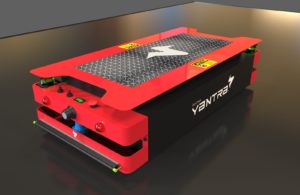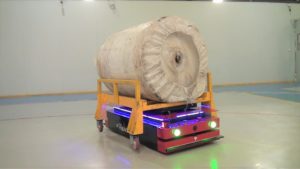 Material Handling in manufacturing sector refers to the movement of any kind of material/load within the limits of shop floor or at the most to the transportation vehicles or warehouses. Auto Guided Vehicles (AGVs) are the newest trend in material handling. AGVs are portable robots, which follow a prefixed path for navigation. They can tow the material stored on trailers and trolleys attached behind them or can store the material on the overhead beds for conveyance. They are used to transport loads in a manufacturing facility or a warehouse, where repetitive movement of material is required with little or no human interaction. Now a days, they are deployed in nearly every industry including automobile, food, pharmaceuticals and textiles, their scope ranging from handling raw materials to finished products. You can learn more about AGVs by clicking here.
Material Handling in manufacturing sector refers to the movement of any kind of material/load within the limits of shop floor or at the most to the transportation vehicles or warehouses. Auto Guided Vehicles (AGVs) are the newest trend in material handling. AGVs are portable robots, which follow a prefixed path for navigation. They can tow the material stored on trailers and trolleys attached behind them or can store the material on the overhead beds for conveyance. They are used to transport loads in a manufacturing facility or a warehouse, where repetitive movement of material is required with little or no human interaction. Now a days, they are deployed in nearly every industry including automobile, food, pharmaceuticals and textiles, their scope ranging from handling raw materials to finished products. You can learn more about AGVs by clicking here.
Today however, since our topic is AGVs in Textile, let us keep our discussion limited to textiles industries. Textile is one of the oldest industries in the world and it is sure to stay in boom forever, well because you know, clothing is one of the fundamental necessities of humans. When we say textiles, it includes spinning, weaving, knitting, stitching. Each process is quite independent on its own. So, there can be different plants for each of the process or a single plant spread across acres with designated area which separate each process. In any case, transporting the material from one place to other is a tedious task mainly because the material is bulky. Imagine transporting tonnes of cotton from warehouse to spinning plant or big rolls of yarn from spinning to weaving.
In earlier days manual labour was used for transporting the material in textile. But as the size of the industries started growing, it became almost impossible to do these tasks manually. Then came the pallet trucks, fork lifts and over-head pick and place mechanisms which are still being used in many textile industries. But all of these still need to be operated by men. Moreover, forklifts and pallet trucks are the major cause of shop floor incidents triggering workers’ safety issues.
AGVs are 100% autonomous requiring no human interaction at all. Due to this the chances of errors are reduced manifolds. Unlike the traditional forklifts, pallet trucks etc they require very low maintenance. As you all know, our standard AGV range at Yantra includes Tugger/Tow type AGVs or Unit load carriers (RAGHAV) and Tunnel Type or Flat Bed AGVs (VAMEN). VAMEN is the most suited product for a textile industry. Its specialised design makes it extremely compact and low height – even less than 300  mm. This makes it very easy to slide under a trolley carrying a big load like 100 meters cloth roll and lift it easily without requiring any manual help. It ensures completely automatic load carriage, from say spinning mill to weaving mill including automated picking and placing of the pallets, carts or trolleys. The specialised mechanism of the AGV bed allows to transport yarns, bobbins, cloth and carpet rolls of up to 500 Kg without the need of any hooking or tying. This saves manual time and effort making 100% automation possible. As we know textile companies have very noisy environment due to several machines operating at the same time. VAMEN can work seamlessly in such noisy as well as high temperature environment. Additionally, it deploys 2 collision detection sensors, one at front and other at rear side while ensuring complete 360 degree protection against safety incidences on factory floor. Due to inherent flexibility and accuracy, it is also ideal alternative to the heavy stationary conveyors or gantries on assembly lines occupying permanent spaces. VAMEN comes in two variants based on navigation technology requiring no floor and structural modifications – Coloured path guidance technology which is 3x more flexible and lower in maintenance than traditional magnetic tape or laser based navigation or a more advanced SLAM based Natural Navigation based technology which relies on static natural features in the environment and does not need additional navigation aids like tapes, reflectors etc. This makes it easier to accommodate in the tight spaces in a textile company.
mm. This makes it very easy to slide under a trolley carrying a big load like 100 meters cloth roll and lift it easily without requiring any manual help. It ensures completely automatic load carriage, from say spinning mill to weaving mill including automated picking and placing of the pallets, carts or trolleys. The specialised mechanism of the AGV bed allows to transport yarns, bobbins, cloth and carpet rolls of up to 500 Kg without the need of any hooking or tying. This saves manual time and effort making 100% automation possible. As we know textile companies have very noisy environment due to several machines operating at the same time. VAMEN can work seamlessly in such noisy as well as high temperature environment. Additionally, it deploys 2 collision detection sensors, one at front and other at rear side while ensuring complete 360 degree protection against safety incidences on factory floor. Due to inherent flexibility and accuracy, it is also ideal alternative to the heavy stationary conveyors or gantries on assembly lines occupying permanent spaces. VAMEN comes in two variants based on navigation technology requiring no floor and structural modifications – Coloured path guidance technology which is 3x more flexible and lower in maintenance than traditional magnetic tape or laser based navigation or a more advanced SLAM based Natural Navigation based technology which relies on static natural features in the environment and does not need additional navigation aids like tapes, reflectors etc. This makes it easier to accommodate in the tight spaces in a textile company.
AGVs save man hours which can be utilized for better requirements, creates a safer work environment and thus improves the overall efficiency and productivity of all the processes. We can say that deploying an AGV in textile industry is definitely the smartest thing to do. Do you agree? Please leave your comments below.


